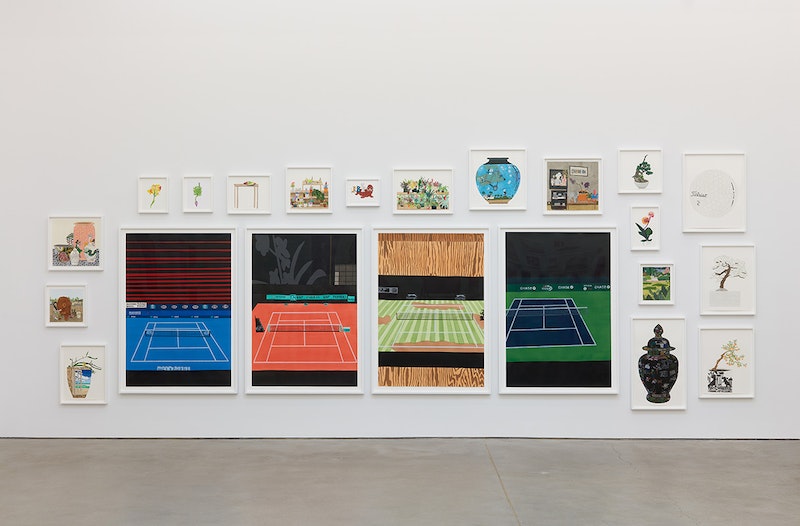July/August 2023

Installation view: Jonas Wood: Drawings 2003–2023, Karma, New York, 2023. Courtesy of the artist and Karma.
Jonas Wood’s exhibition, Drawings 2003–2023, evinces Wood as an artist of inward-looking lyricism. Curated salon-style under the direction of the artist himself, twenty years of works on paper—Wood’s definition of drawing is expansive—illuminate the subtly reflective sensitivity that undergirds a seemingly whimsical art practice. Spider plants unspooling from dotted vases are juxtaposed with toothy portraits of Wood’s children and their disheveled bedrooms. Four sprawling acrylic and colored pencil depictions of tennis courts, each in a different palette, disclose Wood’s proclivity for repetition, further attested to by the multitude of clementine Spalding basketballs. Each wall collates a constellation of ever-burgeoning episodic memories in the making, a phenomenological capture of Wood’s occurrent surroundings and reflections.
An obsessive self-involvedness anchors Wood’s practice, which, at heart, is a chronicling of his lived-in domiciles, both past and present. His portraits are often tethered to his Boston-bedaubed childhood (e.g., Larry Bird [2007]) or his artistic influences (e.g., Hockney [2004]). In terms of content, this fondness for the personal and memorializing that which is ever-fleeting undoubtedly moors Wood to Alex Katz. Yet there is a haptic, frenetic quality to Wood’s work entirely absent from Katz’s portraits, which are much more comfortable letting negative space breathe and sigh. Works like Wood’s My Sisters (2007), Shio and Robot (2008), and Rosy in My Room (2014) feature strewn backgrounds dotted with detritus and abstracted items that threaten to collapse into the foreground. These claustrophobic paintings demonstrate a discomfort with empty space and silence, a sentiment redoubled in the salon-style hanging.
Wood is an artist of the facsimile. Because he is working from reproductions and reproductions of reproductions—including folded-over photographs and projected images of past portraits—a stray watermark of errant blemish might be retained from the first phase to the finished work. This establishes a perceptual destabilization that is especially pronounced in Wood’s domestic interiors and even more so in his portraits, echoing the multiple perspectives that go into his preliminary collages. For instance, in the adumbral Black Still Life (2013), an array of zebra-striped vases—modeled on those thrown by Wood’s wife, the ceramist Shio Kusaka—are stacked, the edge of one bowl sliding into the lip of an adjacent pot.
Triangulated and sharp, there is a naïve quality to Wood’s flat plans, a sketchiness underscored in Wood’s loosely crayon-drawn “Plant” series from 2003. Stylistically, Wood’s botanical still lifes echo Pop artist Marjorie Strider’s late 1950s “Flat Plants,” philodendron leaves reduced to sharp triangles and simple ovals. Steeping his botanical still lifes in narrative, Wood also hews closely to Northern Renaissance progenitors like Jan Davidsz. de Heem (1606–1684), Rachel Ruysch (1664–1750), Jan van Huysum (1746–1822), and Gerard van Spaendonck (1746–1822), all of whom imbued their still lifes with stories. But where these Dutch painters turned towards symbolism, Wood’s narratives are plainly self-referential, apertures into interior spaces that house a biography in the living. Much like episodic memories grow weatherworn and smoothened with age, Wood’s reflections on both the icons of his childhood and the surrounding rooms of his current domicile shirk imitative veridicality, favoring the largesse of smoothened shapes and even, prismatic palettes.
In addition to the botanical still life, sporting is Wood’s motif par excellence. Notably, Wood’s Untitled (Fat Boxer, Boxing Match) (2008) is a far cry from the proto-Social Realism of George Bellows’s champion boxers and equally removed from Matthew Barney’s Apollonian sweat-stained Olympian wrestlers. Sporting does not service idolatry for Wood, instead, licensing his reflection on the motifs that have most been impressed on his memory. Bodily proportions are slightly off-kilter, a byproduct of Wood foregoing perspective in favor of razing. For example, consider the eponymous “fat boxer’s” right breast contracted under his parrying right arm, or the way Larry Bird’s arms sag under his Celtics #33 moss-green jersey, like an over-soaked tea bag threatening to snap.
It would be a mistake to interpret Wood’s potted plants and athletes as symbols or semiotic signs. Wood’s work is utterly unfettered from political duty or thematic conformity, but his self-involvement ought not be taken as a criticism. Wood’s proclivity is for painting what is significant to him: in addition to Wood’s children, there is his wife, collectible trading cards and a bourgeois Los Angeles villa fitted with Picassos, ornate furnishings, and cultivated plants. In one of the cleverest pieces on display, Blue Plant Landscape Pot (2016), Wood inverts a traditional device: instead of the potted plant foregrounding a bustling domicile, Wood’s verdurous backyard garden teems in a vase-cum-window. Through the pot-shaped porthole we see a neatly manicured medley of sprouting flaxen daffodils and festooned chrysanthemums, tables readied for their pruning. In Wood’s case, self-absorption and self-referentiality often leads to fruitful inventiveness and sensuous splendor, making this exhibition well worth viewing.



